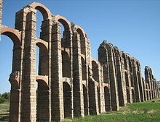
Acueducto de los Milagros
Encyclopedia
The Acueducto de los Milagros ("Miraculous Aqueduct
") is a ruined Roman aqueduct
in Mérida, Spain
, formerly the Roman colony of Emerita Augusta
.
Only a relatively small stretch of the aqueduct still stands, consisting of 38 arched pillars standing 25 metres (82 ft) high along a course of some 830 metres (2,723.1 ft). It is constructed from opus mixtum - granite ashlar
blocks interspersed with red brick - utilising a double arcade arrangement. The structure originally brought water to the city from a reservoir called the Lago de Proserpina
, fed by a stream called Las Pardillas, around 5 km (3.1 mi) to the north-west of Mérida.
It is thought to have been constructed during the 1st century AD, with a second phase of building (or renovations) around 300 AD. In later centuries, the inhabitants of Mérida dubbed it the "Miraculous Aqueduct" for the awe that it evoked.
The aqueduct was one of three built at Mérida, the other two being the 15 kilometres (9.3 mi) long Aqua Augusta, fed by the Cornalvo reservoir
, and San Lázaro, fed by underground channels. The aqueduct is preserved as part of the Archaeological Ensemble of Mérida, a UNESCO
World Heritage Site
.
In the immediate vicinity a small Roman bridge called Puente de Albarregas runs parallel to the arcades.
Aqueduct
An aqueduct is a water supply or navigable channel constructed to convey water. In modern engineering, the term is used for any system of pipes, ditches, canals, tunnels, and other structures used for this purpose....
") is a ruined Roman aqueduct
Roman aqueduct
The Romans constructed numerous aqueducts to serve any large city in their empire, as well as many small towns and industrial sites. The city of Rome had the largest concentration of aqueducts, with water being supplied by eleven aqueducts constructed over a period of about 500 years...
in Mérida, Spain
Mérida, Spain
Mérida is the capital of the autonomous community of Extremadura, western central Spain. It has a population of 57,127 . The Archaeological Ensemble of Mérida is a UNESCO World Heritage site since 1993.- Climate :...
, formerly the Roman colony of Emerita Augusta
Emerita Augusta
The Archaeological Ensemble of Mérida is one of the largest and most extensive archaeological sites in Spain. Mainly of Emerita Augusta, ancient capital of Lusitania . It was declared a World Heritage Site by UNESCO in 1993....
.
Only a relatively small stretch of the aqueduct still stands, consisting of 38 arched pillars standing 25 metres (82 ft) high along a course of some 830 metres (2,723.1 ft). It is constructed from opus mixtum - granite ashlar
Ashlar
Ashlar is prepared stone work of any type of stone. Masonry using such stones laid in parallel courses is known as ashlar masonry, whereas masonry using irregularly shaped stones is known as rubble masonry. Ashlar blocks are rectangular cuboid blocks that are masonry sculpted to have square edges...
blocks interspersed with red brick - utilising a double arcade arrangement. The structure originally brought water to the city from a reservoir called the Lago de Proserpina
Proserpina Dam
The Proserpina Dam is a Roman gravity dam in Badajoz , Extremadura, Spain, dating to the 1st or 2nd century AD. It was built as part of the infrastructure which supplied the city of Emerita Augusta with water....
, fed by a stream called Las Pardillas, around 5 km (3.1 mi) to the north-west of Mérida.
It is thought to have been constructed during the 1st century AD, with a second phase of building (or renovations) around 300 AD. In later centuries, the inhabitants of Mérida dubbed it the "Miraculous Aqueduct" for the awe that it evoked.
The aqueduct was one of three built at Mérida, the other two being the 15 kilometres (9.3 mi) long Aqua Augusta, fed by the Cornalvo reservoir
Cornalvo Dam
The Cornalvo Dam is a Roman gravity dam in Badajoz province, Extremadura, Spain, dating to the 1st or 2nd century AD. The earth dam with stone cladding on the water face is still in use.- See also :* List of Roman dams and reservoirs* Roman architecture...
, and San Lázaro, fed by underground channels. The aqueduct is preserved as part of the Archaeological Ensemble of Mérida, a UNESCO
UNESCO
The United Nations Educational, Scientific and Cultural Organization is a specialized agency of the United Nations...
World Heritage Site
World Heritage Site
A UNESCO World Heritage Site is a place that is listed by the UNESCO as of special cultural or physical significance...
.
In the immediate vicinity a small Roman bridge called Puente de Albarregas runs parallel to the arcades.
See also
- Aqueduct of SegoviaAqueduct of SegoviaThe Aqueduct of Segovia is a Roman aqueduct and one of the most significant and best-preserved ancient monuments left on the Iberian Peninsula...
- Pont du GardPont du GardThe Pont du Gard is a notable ancient Roman aqueduct bridge that crosses the Gard River in southern France. It is part of a long aqueduct that runs between Uzès and Nîmes in the South of France. It is located in Vers-Pont-du-Gard near Remoulins, in the Gard département...

